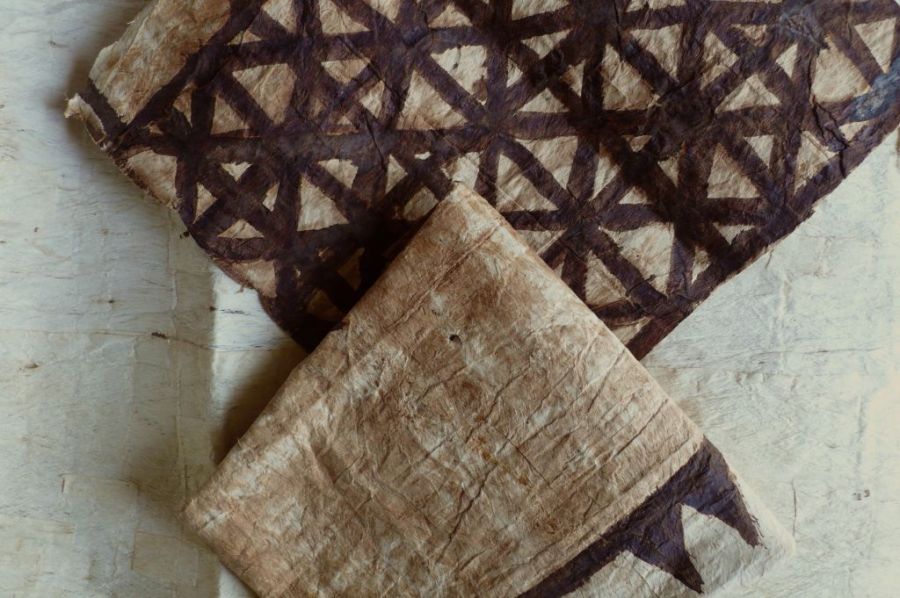ikfoundation.org
The IK Foundation
Promoting Natural & Cultural History
Since 1988


ANDERS SPARRMAN’S OBSERVATIONS
of Tapa Cloth
Sample books, including Tapa or bark cloth, originating from the three circumnavigations of Captain James Cook – 1768 to 1779 – are today spread around the world. One traveller who had a broad interest in these cloths was Carl Linnaeus’ apostle Anders Sparrman, who travelled as an assistant botanist in the company of Johann Reinhold Forster and his son Georg Forster on Cook’s second voyage (1772-1775).
 Tapa samples for ”TEXTILIA LINNAEANA – Global 18th-century Textile Traditions & Trade„ are newly produced (2005) on Tonga using traditional methods. The dyeing substance for the two coloured fabric, was collected from the roots of the mangrove tree, which has been used for decorating fabrics on Tonga for hundreds of years. In the original editions of Sparrman’s books – 1802 and 1818 – the white fabric had been obtained on Tahiti, whereas the two coloured one had been produced on Tonga. (Photo: The IK Foundation, London).
Tapa samples for ”TEXTILIA LINNAEANA – Global 18th-century Textile Traditions & Trade„ are newly produced (2005) on Tonga using traditional methods. The dyeing substance for the two coloured fabric, was collected from the roots of the mangrove tree, which has been used for decorating fabrics on Tonga for hundreds of years. In the original editions of Sparrman’s books – 1802 and 1818 – the white fabric had been obtained on Tahiti, whereas the two coloured one had been produced on Tonga. (Photo: The IK Foundation, London).SAMPLES OF TAPA CLOTH. Sparrman’s interest in bark cloth is further demonstrated in the parts of his journal which were only published many years after his voyage. To both those volumes fabric samples were attached with a descriptive note on their quality; the first consisted of an undyed thin Tapa of a neutral colour which had been brought back from Otaheiti [Tahiti]. There, he reiterated the process of how it was manufactured, pointing out that the stripes had been achieved through the beater’s treatment of the material. It was also noted that the textile could be washed with great care and that a long period of bleaching sunlight whitened the fabric. The other sample in the volume is both painted and varnished to a russet hue. Sparrman wrote: ‘The sample of cloth attached here is from the Friendly Islands [Tonga]’. It was further noted that the varnish protected the cloth quite well against water, even when the islanders swam in the sea. The material was by no means always russet in colour; black, brown or yellow in various patterns were also seen. Therefore, Sparrman must have brought at least two types of bark cloth back to Sweden in 1776.
![Example of clothes made by local bark cloth, used by inhabitants at Ulietea [Raiatea] illustrated 1769 (with some Europeanisation). John Hawkesworth, ”An Account of the Voyages undertaken by the order of his present Majesty for making Discoveries in the Southern Hemisphere…„, vol. 2 plate 7. (‘Dancing at Ulietea’), London 1773.](https://www.ikfoundation.org/uploads/image/2-tapa-ulietea-jpg-900x631.jpg) Example of clothes made by local bark cloth, used by inhabitants at Ulietea [Raiatea] illustrated 1769 (with some Europeanisation). John Hawkesworth, ”An Account of the Voyages undertaken by the order of his present Majesty for making Discoveries in the Southern Hemisphere…„, vol. 2 plate 7. (‘Dancing at Ulietea’), London 1773.
Example of clothes made by local bark cloth, used by inhabitants at Ulietea [Raiatea] illustrated 1769 (with some Europeanisation). John Hawkesworth, ”An Account of the Voyages undertaken by the order of his present Majesty for making Discoveries in the Southern Hemisphere…„, vol. 2 plate 7. (‘Dancing at Ulietea’), London 1773.The two books recording the voyage onboard the Adventure were, as previously mentioned, only published in 1802 and 1818, which means that Sparrman had kept those bark cloths safe for 26 and 42 years, respectively, after his return to Sweden in order for the samples to be attached to those editions. Such a degree of care and planning to do with the cloth must suggest that he regarded them as extremely valuable and essential to be shown off and preserved for a larger public.
Sources:
- Hansen, Viveka, Textilia Linnaeana – Global 18th-century Textile Traditions & Trade, London 2017 (research material, pre-publishing).
- Hawkesworth, John, An Account of the Voyages undertaken by the order of his present Majesty for making Discoveries in the Southern Hemisphere..., 3 vol, London 1773.
- Sparrman, Anders, Resa omkring Jordklotet, I sällskap med Kapit. J. Cook och Hrr Forster. Åren 1772, 73, 74 och 1775. Förrättad och beskrifwen af Anders Sparrman (two volumes), Stockholm 1802 & 1818.
Essays
The iTEXTILIS is a division of The IK Workshop Society – a global and unique forum for all those interested in Natural & Cultural History from a textile Perspective.
Open Access essays, licensed under Creative Commons and freely accessible, by Textile historian Viveka Hansen, aim to integrate her current research, printed monographs, and earlier projects dating back to the late 1980s. Some essays feature rare archive material originally published in other languages, now available in English for the first time, revealing aspects of history that were previously little known outside northern European countries. Her work also explores various topics, including the textile trade, material culture, cloth manufacturing, fashion, natural dyeing, and the intriguing world of early travelling naturalists – such as the "Linnaean network" – viewed through a global historical lens.
For regular updates and to fully utilise iTEXTILIS' features, we recommend subscribing to our newsletter, iMESSENGER.
been copied to your clipboard




– a truly European organisation since 1988
Legal issues | Forget me | and much more...
You are welcome to use the information and knowledge from
The IK Workshop Society, as long as you follow a few simple rules.
LEARN MORE & I AGREE







